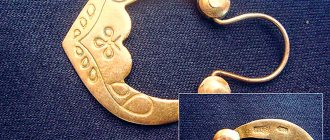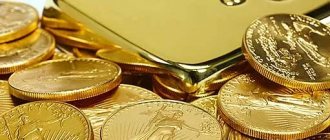Where is all the gold?
The World Gold Council estimates that throughout history, miners have extracted a total of 201,296 tons of gold, with another 53,000 tons remaining in explored underground reserves.
If all above-ground reserves are represented as a single alloy, the result is a cube measuring only 22 meters on each side, which confirms the rarity of gold.
But where is all this metal?
Almost half of all gold ever mined is used to create jewelry. India and China are considered the largest consumer markets for gold and accounted for more than 50% of global gold jewelry demand in 2021.
People around the world invest in gold for its ability to store value, and when inflationary pressures are high, the precious metal often serves as a safe haven asset.
Consequently, investment is one of the main end uses of the gold metal, with over 44,000 tonnes held in the form of bars, coins or ETF collateral.
In addition to investors, central banks are among the largest holders of gold. Unlike foreign exchange reserves, stocks and bonds, the price of a precious metal depends largely on supply and demand. Therefore, central banks often use gold to diversify their assets and protect against the depreciation of fiat currencies.
Central bank gold holdings account for almost one-fifth of all onshore gold. As of 2021, official reserves exceeded 35,000 tons.
Although gold is a precious metal, it also has various industrial applications, such as in electronics, dentistry and space technology. It is estimated that a typical iPhone contains about 0.034 grams of gold in addition to other precious metals. These industrial uses account for 29,448 tonnes or approximately 15% of all aboveground gold reserves.
Gold online
Gold is one of the most important components of the global financial system. This precious metal has a large number of applications and is not subject to corrosion than its cheaper counterparts.
Gold price today
In many ways, gold is quite interesting from the point of view of savings, because even in times of serious disasters it only accumulates. The Gold online chart updated in real time, and in order to know what the price of Gold online is, simply save the page to your favorites and, if necessary, you will always be aware of the current prices for XAU/USD.
Gold quotes for today
Recently, we can observe a serious drop in quotations for Gold, however, we cannot talk about the continuation of the current trend and, most likely, in the near future we will see an increase in the cost of gold. Moreover, during times of serious financial crises, Gold can greatly increase in price. To find out Gold quotes for today, just look at the chart presented above; if you see a price of 1150, this means that for one troy ounce they give 1150 dollars on world markets.
Gold price
Today, the price of Gold on the exchange has reached the level of 2009, but at that time the cost of xau usd was in a serious upward trend during the financial crisis of 2008. It is quite possible that this price of Gold on the stock exchange today will not last long and in the near future there will be a new round of growth for GOLD.
GOLD chart online
Above is an online GOLD chart that shows the value of xau/usd expressed in US dollars at a given time on the global financial markets of London and New York. The chart is updated automatically, so you just need to look at the current quotes to see the GOLD chart online .
Gold to Dollar rate
Historically, the dollar exchange rate was pegged to Gold, and world currencies to the dollar. However, such a system could not exist for long and countries switched to a floating exchange rate, and the United States, in turn, abandoned the pegging of the Gold rate to the Dollar, which led to a serious increase in prices for the precious metal GOLD in the next few years. Today, prices on world markets for Gold are expressed in dollars per ounce; on the presented chart, Gold Chart (XAU/USD) online, you can track the Gold to Dollar exchange rate for today in real time.
Gold price per ounce today
A troy ounce is a unit of mass, it is equal to 31.1034768 grams, so when we see a quote of 1200 on the chart of Gold (XAU/USD) online , it means that for 31.1034768 grams GOLD gives 1200 US dollars. The price of gold at 19.3 dollars per 1 ounce was established back in 1792 in the United States of America. During the gold standard, the price was already at $35 per ounce. At the time of the collapse of the Bretton Woods system, the cost of gold began to rise, and was already worth about $200 by 1978.
How much does Gold cost on the market?
The price of XAU/USD is constantly changing, so it is impossible to say how much Gold is worth on the market; in order to see the current prices of the precious metal, use the charts above. Where you can find out how much Gold costs on the market now or how much it cost yesterday.
Gold price dynamics, Gold price chart
The dynamics of gold prices is a unique economic indicator that can tell us whether the markets are now in crisis; if the value of gold rises rapidly, then we can talk about the development of a serious financial crisis, as investors flee to gold, and gold an asset that will always be in value.
Underground reserves
Before being turned into jewelry and bullion, the precious metal goes through several stages in the supply chain, starting with mineral exploration and mining. As of 2021, the studied gold reserves in the world amounted to 53,000 tons.
Given the availability of such reserves, it is not surprising that Australia, Russia, the United States and Peru are among the largest producers of the gold metal in the world. In 2021, China increased production.
These reserves not only help determine current production, but also provide insight into where future production may develop.
In 2021, mining companies produced just over 3,000 tons, and at this rate, underground reserves will last for 18 years without new discoveries. However, it is important to note that reserves can change and grow as explorers find new deposits in different parts of the world.
Citi told when and to what levels gold will rise in price
gold price chart at 4 hour intervals
Gold prices continued to rise on Thursday following higher-than-expected U.S. inflation, but Citigroup strategists warned the precious metal's rally could be limited to the winter.
“If gold prices hold at around $1,850 an ounce this week, fresh investor influx is likely and $1,900 an ounce could become the next upside target,” a team of Citi strategists led by Aakash Doshi said in a note to clients late Wednesday evening. “However, a stronger US dollar and rising Fed rate hike expectations in STIR [short-term interest rate] markets are headwinds for gold prices, even as inflation momentum looks strong,” Doshi said.
On Thursday, gold for December delivery rose $15, or 0.85%, to $1,864.50 an ounce, hitting another closing level not seen in months. On Wednesday, gold rose $17.50, or 1%, to $1,848.30 an ounce on the Comex, its highest close since mid-June, according to FactSet data.
The jump in quotations followed an increase in the consumer price index by 0.9%, which is significantly higher than the 0.6% expected by economists. Annual inflation rose to 6.2%, the biggest jump in 31 years. No data available for Thursday due to the Veterans Day holiday.
“Concerns about more persistent inflation or even the possibility of stagflation are supporting demand for inflation-indexed bonds (TIPS), gold and crypto, which could persist in the short term as the November CPI should continue to show strength,” Doshi and his team said .
Gold's gains coincided with the dollar's strength on Thursday. The US dollar, as measured by the ICE US Dollar Index, rose 0.2% to 95.053. The strength of the dollar often puts pressure on dollar-denominated gold prices.
Citi raised its three-month gold price target by 11% to $1,900 an ounce, and raised its fourth-quarter forecast to $1,800 an ounce from $1,700.
Doshi said they have priced in "big tail risk" for commodities, so the precious metal could reach new nominal highs above $2,100 an ounce next year . However, their base case is bearish for the second half of 2022-23.
They expect the Fed to signal an acceleration in the pace of quantitative easing reduction at the December FOMC meeting.
December silver contracts rose along with gold prices, rising 26 cents, or 1%, to $25.03. Silver rose 1.9% to $24.772 an ounce on Wednesday, the contract's highest close since early September. Among other metals, copper for December delivery rose 1.1% to $4.372 a pound. Platinum for January delivery rose 1.3% to $1,090 an ounce and palladium for December delivery rose 0.5% to $2,048.50 an ounce.
Barbara Kollmeyer, Dow Jones Newswires
MarketSnapshot — ProFinance.Ru news and market events on Telegram
On this topic:
Gold Jumps After US Inflation Data Beats Expectations
Where to buy gold for savings?
1. The simplest option is to invest money in gold at Sberbank, for example, in unallocated metal accounts, the so-called compulsory medical insurance. In your personal account, the transaction can be completed in minutes, VAT is not assessed on purchases/sales, and the risk of losing treasure is minimal. In exchange for your money, the bank provides a statement stating that you are now the owner of so many grams of precious metal. Virtual gold can be purchased in small quantities, stored for as long as desired, and sold at any time at the current rate. You can also “withdraw” your bullion from your account, but the commission will be significant: for example, at Sberbank for a 1-gram piece - 600 rubles (more than 20% of the price), for 100 grams - 2520 rubles (about 10%).
In fact, with such a price for the “materialization” of the metal and the arbitrary establishment of the purchase/sale rate, impersonal gold for banks is nothing more than a means of attracting investor funds, like a deposit, but the interest on which is not fixed and the funds are not insured.
In addition to the commission upon receipt, the large difference in purchase and sale rates, the lack of insurance, the disadvantages include the fact that interest is not accrued on funds for compulsory medical insurance, all profit or loss is determined solely by changes in the world price of gold and the exchange rate of a particular bank. So, at the time of writing, Sberbank was selling gold at a price of 2993 rubles/gram, and buying it back at 2720 rubles/gram. The spread is about 10%.
Another significant disadvantage: when selling metal, you must file an income tax return and pay income tax on profits if the unallocated metal was owned for less than 3 years (13% for residents). But you can take advantage of a property deduction of up to 250,000 rubles.
Let's consider a real example: the difference between the price of gold sales by Sberbank over the year was about 20%. But the difference between the sale price and the buyback is only 9%. Essentially, for the compulsory medical insurance account holder, this is a return on investment. Let's subtract personal income tax and get a little less than 8% (personal income tax is not taken into account when owning virtual metal for more than 3 years). The maximum interest rate on a deposit for that period in the same Sberbank was about 7%. That is, over the past year, those who invested in compulsory health insurance would have gained a little - about 1%. But a year earlier, a similar investment would have brought less than any contribution - only about 1% per year.
2. The second option seems more reliable - buy gold coins and bars in banks. But! In Russia, an individual can purchase bullion from precious metals only within the banking system. When purchasing, VAT is added to the cost of the bullion in the amount of now 20%, and when selling back to the bank, VAT is not returned to the individual. That is, in addition to the difference between the purchase and sale prices, there is a 20% tax. The government is once again discussing the abolition of VAT on investment gold; if it passes, the bullion will become a popular alternative to the dollar and euro, demand will increase, which will again increase its price. Due to commissions, real gold is more expensive than virtual gold, and here you need to have good faith in its success or consider significant time horizons.
3. The author still likes the third option - buying retail gold - jewelry (rings, earrings, chains, bracelets, etc.). Both decoration and investment. Only the price per gram in a jewelry store is much higher than the price of pure metal... Where is the benefit? Indeed, the price of the product already includes the painstaking work of the jeweler, the entire sales network, and often the weight of the stones.
The price of unredeemed collateral in a pawnshop is closest to the market price. Gold pledges, which are usually used, can be sold by a pawnshop only to two places: to ordinary citizens or to factories at the price of scrap. Therefore, the price per gram here is the most adequate, one might say, equal to the world price. So, you can find pawn shops with a price of 1,700 rubles per gram of 585 purity - that’s 2,900 per gram of the purest yellow metal. Almost the world market price. If necessary, this gold can again be handed over to a pawnshop or purchased at a lower price - the market average is 1500-1550 rubles. That is, the purchasing commission - the difference between the price of a one-time purchase and sale - will be about 8%. For comparison: in the case of currency, the difference in the rates of one-time purchase and sale is about 4%.
And finally, a chart of gold prices over the past 20 years. Let's remember it this way and follow the new history of ancient gold after Basel III comes into force.
Gold price chart for the last 20 years Source: mfd.ru
Gold will rule the world: Should we urgently exchange dollars for “jewelry”?
Global gold prices continue to rise steadily. International analysts predict a new renaissance for the yellow metal, as the currencies of developed countries may begin to depreciate due to the coronavirus pandemic. Will gold begin to rule the world due to a new Great Depression in the USA, is it worth buying jewelry now, and what awaits Russia?
Recent weeks and months have been paradoxical in terms of the cost of goods that are in global demand. If oil has already depreciated to $0.00 per barrel and even entered the negative price zone, then the price of gold moves in the opposite direction with exactly the same zeal.
Ambitious in its liberal predictions, Bank of America released a loud forecast for rising prices for the yellow metal. According to bank analysts, the price of gold will reach $3,000 per troy ounce by October 2021. At the same time, the United States has already printed 2.3 trillion dollars out of thin air, and European countries - more than half a trillion euros.
To what extent does this indicate the onset of a new Great Depression in the United States, which economists are already warning about? Does this mean it's time to get rid of these currencies in favor of the yellow metal? In continuation of the conversation about gold, Tsargrad addressed these questions to the professor of the Department of International Finance at MGIMO, the head of the Russian Economic Society. S.F. Sharapova to Valentin Katasonov.
Let's start buying jewelry
– Valentin Yuryevich, how much sense does it make to buy jewelry with the current rise in gold prices and what risks there may be in this against the backdrop of increasing demand?
– I believe that the demand for gold is already very high. Moreover, gold comes in different forms. There is gold of a high standard, sometimes it is verified, and sometimes it is not so verified. Therefore, cases arose when people were sold certain counterfeits and surrogates through the retail trade. In principle, the movement of gold in recent years has been very active, but not so much through “jewelry” as through pawn shops.
A lot of valuable gold passed through them. Those who understand what gold is have always tried to hang around pawn shops, and not around jewelry stores. There you could buy gold at a very reasonable price. There were always people around the pawnshops, because most of the products that ended up there were then put up for sale. They tried to bring some order to this so that collateral items would not be put up for competition, but pawnshops have acquired their own retail outlets. If any competitive sales were held there, it was all for reporting purposes only.
People who tried to sell “jewelry” at jewelry stores later bore serious responsibility. Photo: Andrey Makhonin/TASS
But they also work with gold according to a different scheme, when unaccounted for gold is used either from mines or from refineries. In the 90s there was such a terrible mess at our factories that gold was stolen there in tons.
– Now there is a risk of a black market emerging again?
– Is this a white market around pawn shops? It's more of a grey. Because the black market arises not just when there are certain regulations on gold trading, but when bans on gold trading are introduced. There was a black market, for example, in the USSR, where gold was considered a currency value with a ban on credit or collateral transactions.
I know examples where people who tried to sell “jewelry” from their hands at jewelry stores later bore serious responsibility. I am familiar with such cases, as they say now. I do not rule out that at some point we may have bans on gold trading, and then a black market will arise.
By the way, the largest black market was in the USA. It existed from 1933 until about 1973. In 1973-1974, the provisions of the 1933 presidential decree banning transactions with gold were completely repealed. After all, then, in the 30s, the yellow metal was confiscated and even criminal liability was introduced for storage and trade. Many people think that the black market for gold ended after the war, but no, in fact it only happened in 1973-1974.
– Now we are expecting an explosive growth in demand for gold and jewelry in Russia?
– Today in Russia the demand for jewelry will grow, and it will be greater than usual. But at the same time, it is difficult to say how the Russian jewelry industry will work, because supplies have been reoriented to foreign markets. Now it is no longer possible to trace the fate of Russian gold in England, where more than 90% of our yellow metal produced in Russia now goes. These supplies bypass the Central Bank, and Russian gold mining companies have already received licenses to export this gold. The Federal Customs Service may still have some information, but they only see the first link, which is England.
– The head of the Central Bank of Russia, Elvira Nabiullina, stated that Russia will not sell accumulated gold in the foreseeable future. At the same time, we see how the share of foreign currency in our reserves is sharply declining. How dangerous is this?
- It is very dangerous. We must buy gold, and 100% of our own production, otherwise we are playing to strengthen our opponents. Nabiullina very cleverly avoided this issue. She simply said that she would not sell, but did not touch upon the question of why the Central Bank is not now increasing reserves of an asset that generates profit. Complete deceit.
Who has the most gold
– Which countries buy and sell gold the most?
– Gold routes are generally very difficult to study. It is believed that the largest exporters of gold are two countries - the USA and Switzerland, paradoxically. But the US trades mined primary gold. And Switzerland is the largest importer of the yellow metal, which then re-exports it. The world's largest refineries are located there. Switzerland processes the gold and then it goes to China, which is the largest importer. By the way, China itself produces 400-500 tons per year, but it doesn’t have enough, and so they buy additional raw materials, from which they then get another 100 tons. Plus they imported approximately 800-900 tons through Hong Kong.
According to experts, China now has at least 5,000 tons of gold. Photo: x99/ZUMAPRESS.com/Globallookpress
The Chinese leadership says that gold goes to the open market, but there are good reasons to believe that this is not the case. Of course, active gold trading is carried out on the Shanghai and Hong Kong stock exchanges, but still the gold ends up somewhere in government storage facilities. Chinese statistics have generally frozen in one place. Their gold volumes, according to official data, are about 1,900 tons, and they change this figure discretely, every six months. It feels like they buy it once every six months. Of course this is not true.
According to experts, China now has at least 5,000 tons of gold. Some economists say that it is China that is the owner of the world's main gold reserves, and not the United States. Although officially, from year to year, the Americans give the same figure - 8100 tons. But my feeling is that the gold from Fort Knox has already gone somewhere.
There are a lot of tricks in the world of gold. The peculiarity is that the IMF at one time approved a number of standards for accounting for gold transactions. If you previously sold gold or lent it out, this was reflected in the financial statements. But now gold can be given on credit or lease, and this is not reflected in the reporting. The point is that the IMF is under the control of the United States and acts in the interests of the “masters of money”, who needed to press gold “to the plinth” and withdraw it for gold interventions.
This is a very taboo topic in the US. It is known that for several decades the US Congress raised the question of the need to audit gold reserves, but not a single attempt passed. The last time such an audit was carried out was in the early 1950s.
The end of the American hegemon
– In the United States, there are increasingly frequent forecasts that the country will face a crisis comparable to the Great Depression. Can they save themselves in gold?
– I think that the situation could be much worse than in the 30s of the 20th century. From a geopolitical perspective, the United States is heading full steam ahead toward disaster. All these quantitative easings are like a situation where they took off on a plane and have nowhere to land.
And if we talk about gold, its world market is no longer built on a cartel principle. Previously, it was very clearly regulated, and even the word “market” should have been used in quotation marks. It is now very difficult to buy a large quantity of physical gold on the market.
It’s like in the USSR, when there was the State Committee for Prices, which determined prices for any goods. For example, for women's mink coats or televisions, tape recorders. You come to the store and there is nothing. But the price is reasonable. The gold market, from my point of view, is like in the Soviet GUM - there are price tags, but no goods. And in these actual conditions, we still allow our physical gold to be exported abroad.
– A barrel of WTI oil recently reached $0, and then the price was even negative. Against this background, Bank of America issued a very loud forecast for an increase in the price of gold to $3,000. This is a signal to rich people to go into gold, getting rid of the dollar. The world's number one reserve currency faces problems ?
– This is a likely scenario, but the question is still open: will this happen smoothly or abruptly? As I said, I am inclined to believe that the collapse of the dollar will be rapid. But let's remember the example of the Amero, a supranational currency that they thought of introducing to serve the USA, Canada and Mexico. Everyone was very tense then, but nothing happened, of course, no Amero appeared.
But everyone was discussing: if this currency appeared, the dollar would have to be withdrawn from circulation. And this means carrying out a monetary reform, in which, as a rule, the exchange does not occur in full. Some of the banknotes are not exchanged for some reason. For example, with the wording “you must prove that your money is not dirty.”
There are documents that prove that with such a development of the situation, not a single dollar from the Russian economy will be exchanged for a new monetary unit. Here you go. The old dollar is no longer there, the United States is starting to live with a clean slate, and at the same time they screwed everyone, and in a civilized way.
– Have we encountered anything similar?
– We already went through all this in the 20th century. Back in the 1920s, Russia was under a strict blockade, even without diplomatic relations with Western countries. But under these conditions, we not only learned to survive, but also industrialization began in 1929. The West did not even immediately understand what was happening, and also blew into our sails with its global crisis.
Today in Russia the demand for jewelry will grow, and it will be greater than usual. Photo: U Aung/Globallookpress via ZUMA Press
Formally, no one lifted the restrictions from us. We developed under the conditions of the gold and credit blockade. But during a crisis, American companies often spat on the prohibitions of all these State Departments. And at that time, the West realized that it was losing not only politically, but also ideologically, because the USSR, against the backdrop of this depression, performed an economic miracle, which continued after the Second World War.
By the way, we also had experience in creating a supranational currency, which was called the transferable ruble, this was 1964. But it had a fundamental difference with what we later saw in Europe. At that time, the European Union did not yet exist; there was the European Economic Community, which until 1960 used European currency clearing, and then they introduced the American dollar.
It was only in the 1970s that the currency unit ECU appeared, which was replaced by the euro as we know it today. But we were the first, and the EU countries live under the euro, having lost their national currencies. And in our Council for Mutual Economic Assistance (CMEA), which was organized by the USSR, countries retained their German marks and Polish zlotys. That is, we did not kill the currencies of these countries, unlike the European Union. Therefore, we had a more correct system that did not encroach on the national sovereignty of the CMEA countries.
Please note that when the West talks about countries of the socialist camp, they call them exclusively Warsaw Pact countries, and do not mention CMEA. They are afraid of this mention.
Is it profitable to invest money in gold?
But these are all big games, but what should an ordinary person do and why does he need gold? About the same thing that countries need: to preserve what they have acquired, to save money from inflation and devaluation. And precious metals are starting and winning here.
The table below shows the approximate value of gold and the dollar over a period of 21 years at various intervals. It can be seen that the 1998 crisis increased the price of the dollar by 4.5 times, and the increase in the price of gold due to two factors - the real exchange rate on the international market, and the increase in the price of the currency gave an increase of almost 10 times. In other words, if you invested equal amounts of rubles in the dollar and in gold, then after selling them after the crisis on gold you would have earned 2 times more.
During the 2014 crisis, the situation was a little worse: with a similar strategy, investing in the dollar would have been 20% more profitable than in gold, but during this period, as noted above, there was already a forced reduction in gold prices on the global market. In any case, the gain from investing is 1.8 times compared to the ruble. Let's calculate, on a very average basis, today's gold and dollar prices to the rates of the crisis years. And we clearly see that the ruble price of gold is growing stronger than the dollar!
| Assets | July 1998 | July 2006 | July 2008 | July 2009 | July 2011 | July 2012 | July 2013 | July 2014 | July 2015 | July 2019 | June 2021 to July 1998 | June 2021 to July 2008 | June 2021 to July 2015 |
| Dollar, rub. | 6 | 27 | 23 | 33 | 28 | 32 | 32 | 35 | 57 | 63 | 10,5 | 2,7 | 1,1 |
| Gold 999, rubles/gram | 60 | 560 | 710 | 940 | 1440 | 1650 | 1340 | 1450 | 2030 | 2840 | 47,3 | 4,0 | 1,4 |
| 999 gold, dollar/ounce | 260 | 654 | 950 | 937 | 1600 | 1571 | 1240 | 1300 | 1154 | 1413 | 5,4 | 1,5 | 1,2 |
Conclusion - investing money in gold for the long term is the most profitable option. Gold grows - profits grow, the dollar grows - the price of your gold still rises. The growth of gold combines with the growth of the currency and gives a good multiplier.










